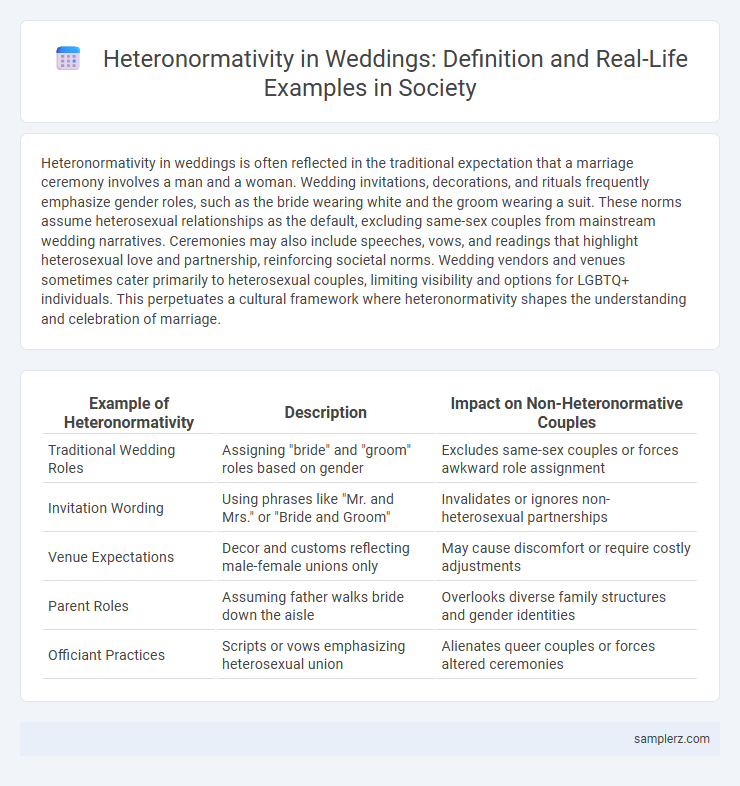Heteronormativity in weddings is often reflected in the traditional expectation that a marriage ceremony involves a man and a woman. Wedding invitations, decorations, and rituals frequently emphasize gender roles, such as the bride wearing white and the groom wearing a suit. These norms assume heterosexual relationships as the default, excluding same-sex couples from mainstream wedding narratives. Ceremonies may also include speeches, vows, and readings that highlight heterosexual love and partnership, reinforcing societal norms. Wedding vendors and venues sometimes cater primarily to heterosexual couples, limiting visibility and options for LGBTQ+ individuals. This perpetuates a cultural framework where heteronormativity shapes the understanding and celebration of marriage.
Table of Comparison
| Example of Heteronormativity | Description | Impact on Non-Heteronormative Couples |
|---|---|---|
| Traditional Wedding Roles | Assigning "bride" and "groom" roles based on gender | Excludes same-sex couples or forces awkward role assignment |
| Invitation Wording | Using phrases like "Mr. and Mrs." or "Bride and Groom" | Invalidates or ignores non-heterosexual partnerships |
| Venue Expectations | Decor and customs reflecting male-female unions only | May cause discomfort or require costly adjustments |
| Parent Roles | Assuming father walks bride down the aisle | Overlooks diverse family structures and gender identities |
| Officiant Practices | Scripts or vows emphasizing heterosexual union | Alienates queer couples or forces altered ceremonies |
Common Heteronormative Traditions in Wedding Ceremonies
Common heteronormative traditions in wedding ceremonies include the bride wearing a white dress symbolizing purity and the groom wearing a tuxedo, reinforcing traditional gender roles. The practice of the bride "walking down the aisle" and being "given away" by a male relative emphasizes patriarchal control and the presumption of heterosexual unions. Vows and rituals typically prioritize romantic love between a man and a woman, often excluding diverse expressions of gender and sexuality.
Gendered Wedding Roles: Bride and Groom Expectations
Traditional weddings often reinforce heteronormativity through rigid gendered roles, with the bride expected to embody femininity by wearing a white dress and focusing on beauty, while the groom assumes a masculine role centered on financial provision and leadership. These expectations perpetuate binary gender norms and exclude non-heterosexual couples or those who challenge conventional gender identities. By enforcing the bride's emotional responsibilities and the groom's authority, such roles maintain systemic social inequalities embedded in the wedding ceremony.
The Language of Wedding Invitations and Programs
Wedding invitations and programs often reinforce heteronormativity by using gendered language such as "bride and groom," presuming a heterosexual couple as the default. Phrases like "his bride" or "her groom" exclude same-sex couples and rigidly adhere to traditional gender roles. Innovative couples now opt for inclusive language like "partners" or simply using names to reflect diverse relationships.
Dress Codes and Attire Norms Reinforcing Heteronormativity
Traditional wedding dress codes often reinforce heteronormativity by prescribing white gowns for brides and black tuxedos for grooms, aligning with gender binaries and heterosexual expectations. These attire norms emphasize a binary understanding of gender roles, marginalizing non-binary, transgender, or same-sex couples who may not conform to these standards. The enforcement of these dress codes perpetuates societal norms that privilege heterosexual unions and exclude diverse expressions of identity.
The “Bride’s Side” vs. “Groom’s Side” Seating Arrangement
Heteronormativity in weddings often manifests through the traditional "Bride's Side" vs. "Groom's Side" seating arrangement, which reinforces gender binaries and heteronormative expectations. This practice assumes a heterosexual union and divides guests based on the bride's and groom's families, ignoring the diversity of modern relationships and family structures. Such seating conventions perpetuate gender norms and marginalize non-heterosexual couples by enforcing outdated social roles.
Heteronormative Rituals in Wedding Vows
Wedding vows often reflect heteronormative rituals by emphasizing traditional gender roles, such as the bride promising to "obey" the groom or pledging to adopt a new family name. These conventions reinforce the expectation that marriage involves a male-female binary and predetermined roles within the relationship. By embedding these norms in vow language, weddings perpetuate heteronormativity and marginalize diverse expressions of love and partnership.
Exclusion of LGBTQ+ Couples from Wedding Customs
Traditional wedding customs often reinforce heteronormativity by centering ceremonies around heterosexual couples, excluding LGBTQ+ couples from full participation and representation. Common practices such as the "bride and groom" roles, parental expectations, and gender-specific attire perpetuate this exclusion by invalidating non-heteronormative relationships. This systemic reinforcement results in social marginalization and a lack of visibility for diverse love expressions within marriage rituals.
Representation of Relationships in Wedding Marketing and Media
Wedding marketing and media often reinforce heteronormativity by predominantly showcasing heterosexual couples in their advertisements and promotional materials. This narrow representation marginalizes LGBTQ+ relationships, limiting visibility and inclusivity in mainstream wedding culture. Expanding marketing narratives to include diverse partnerships can challenge traditional norms and foster broader acceptance of varied relationship dynamics.
Legal and Religious Constraints Favoring Heterosexual Marriages
Legal frameworks in many countries historically defined marriage strictly as a union between a man and a woman, limiting recognition and rights for same-sex couples. Religious doctrines, particularly within Christianity, Islam, and Judaism, often endorse heteronormative marriage, framing it as a sacred covenant exclusively between opposite-sex partners. These combined legal and religious constraints enforce societal norms that privilege heterosexual marriages, marginalizing LGBTQ+ individuals in matrimonial contexts.
The Pressure for Gender-Conforming Wedding Parties
Heteronormativity in weddings often manifests through the pressure to have gender-conforming wedding parties, where brides are expected to have bridesmaids and grooms have groomsmen. This rigid structure reinforces traditional gender roles and excludes non-binary or LGBTQ+ individuals from meaningful participation. Social expectations linked to heteronormative customs create emotional stress for couples who wish to honor their authentic identities during wedding ceremonies.

example of heteronormativity in wedding Infographic
 samplerz.com
samplerz.com